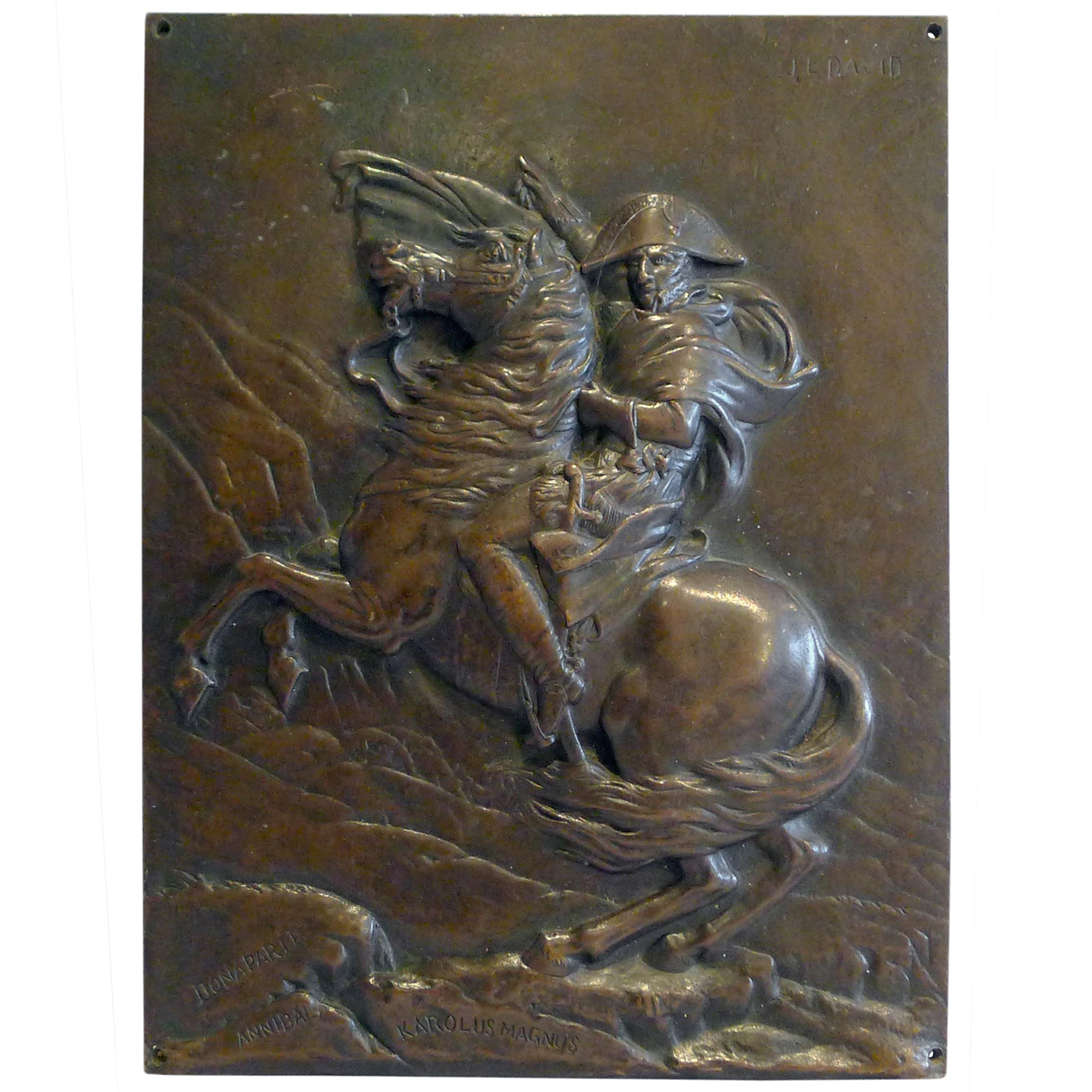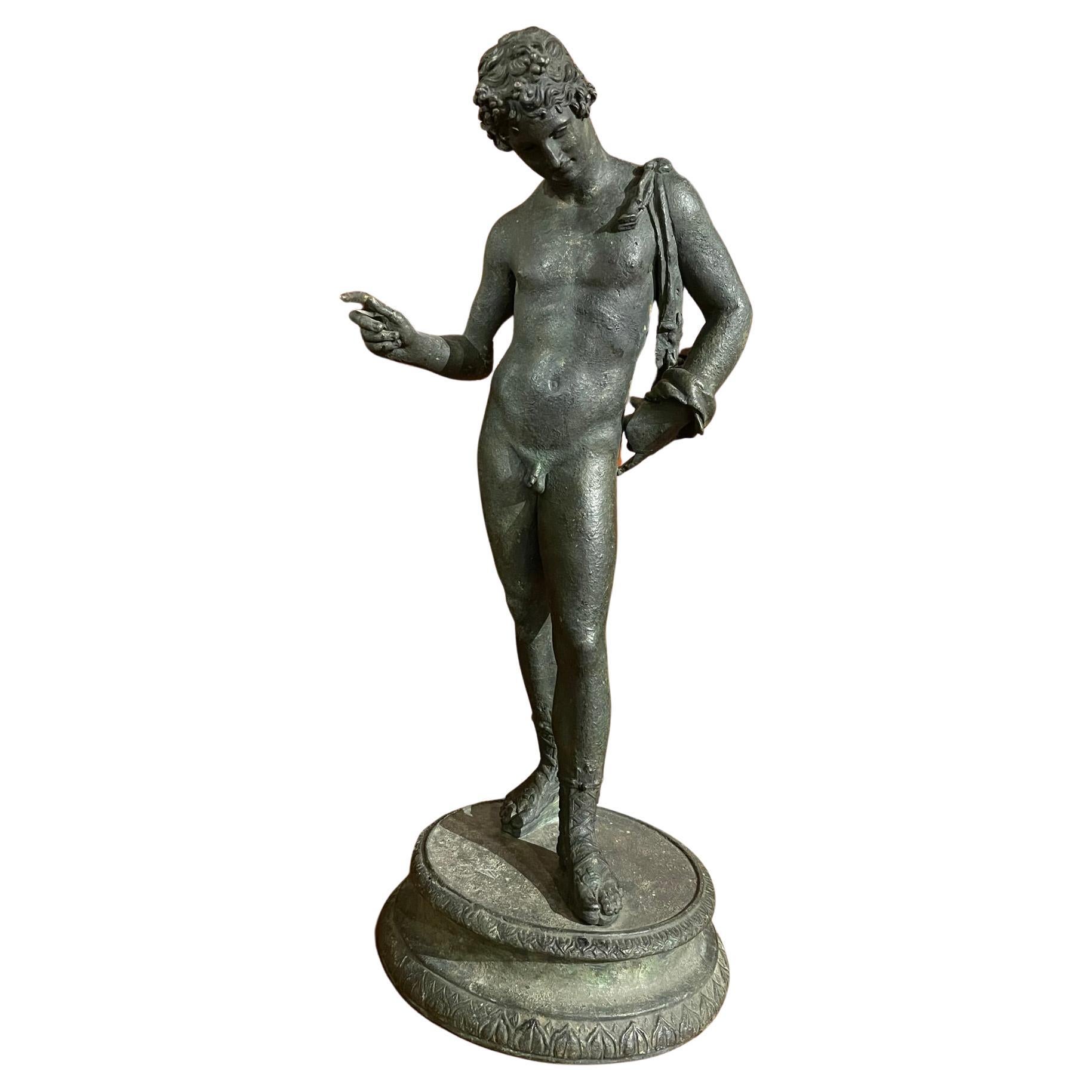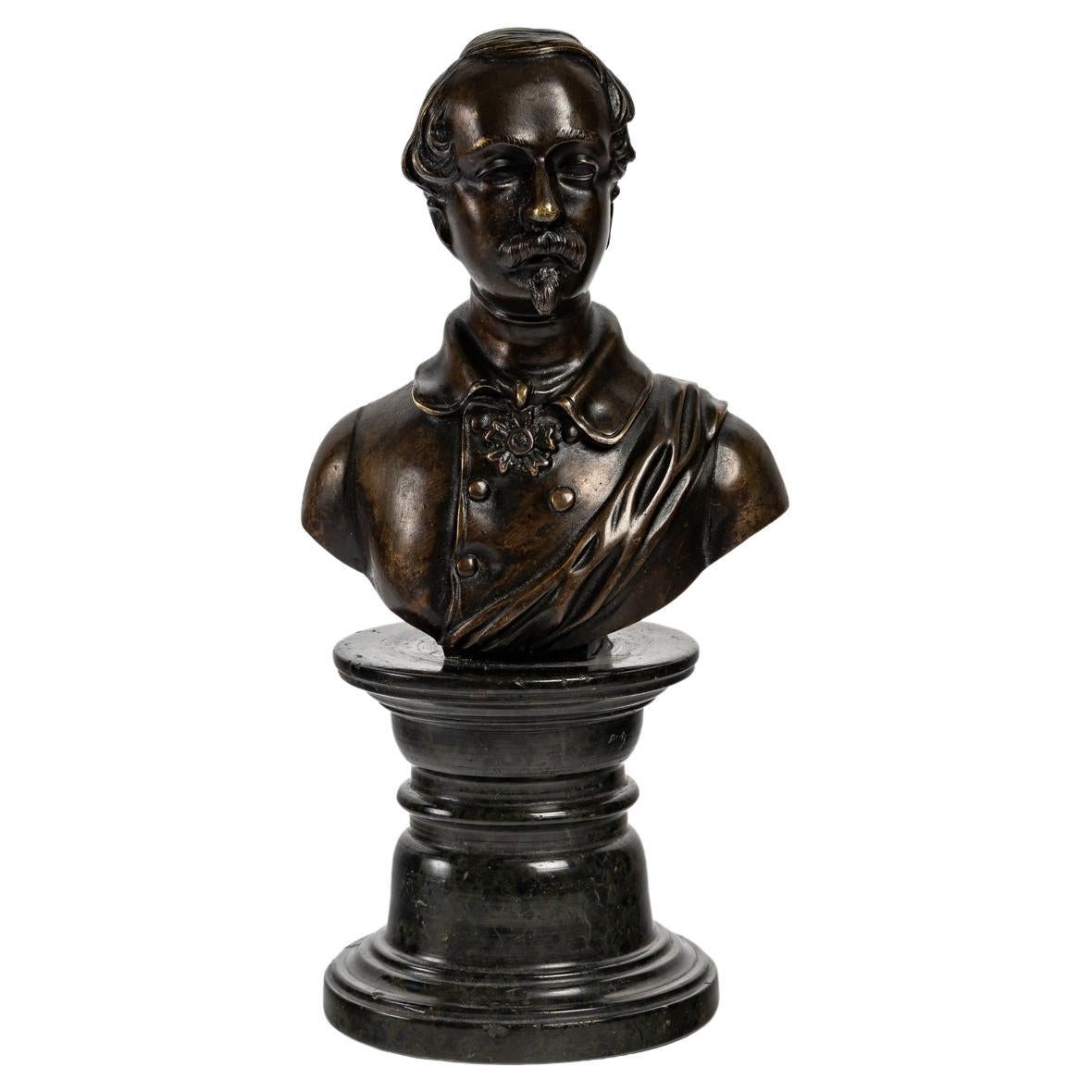Items Similar to 19th Century Bronze Sculpture of Napoleon Crossing the Alps
Want more images or videos?
Request additional images or videos from the seller
1 of 8
19th Century Bronze Sculpture of Napoleon Crossing the Alps
About the Item
PRESENTING A LOVELY late 19C Bronze Sculpture of Napoleon Crossing the Alps.
19th Century Bronze of Napoleon on Horseback in Battle, with canon, etc at his feet and on his favorite horse, Marengo!
This sculpture is based upon the famous painting of “Napoleon Crossing the Alps” by Jacques Louis David circa 1805.
Napoleon Crossing the Alps (also known as Napoleon at the Saint-Bernard Pass or Bonaparte Crossing the Alps) is the title given to the five versions of an oil on canvas equestrian portrait of Napoleon Bonaparte painted by the French artist Jacques-Louis David between 1801 and 1805. Initially commissioned by the King of Spain, the composition shows a strongly idealized view of the real crossing that Napoleon and his army made across the Alps through the Great St. Bernard Pass in May 1800.
We are of the opinion that this sculpture is from circa 1890 and is a wax mold re-casting.
We cannot find a signature, but it has good detail and naturally aged patina.
On black (white veined) marble base.
Quite a heavy piece, weighing 40lbs!
Dimensions: 15.2 inches Wide, 15.25 inches Tall and 8.25 inches Deep
Provenance: Bought in Ireland at Auction.
Condition: Very Good.
- Dimensions:Height: 15.25 in (38.74 cm)Width: 15.2 in (38.61 cm)Depth: 8.25 in (20.96 cm)
- Style:Napoleon III (In the Style Of)
- Materials and Techniques:
- Place of Origin:
- Period:
- Date of Manufacture:1890
- Condition:Wear consistent with age and use. Very Good Condition.
- Seller Location:Dallas, TX
- Reference Number:1stDibs: LU3978111878801
About the Seller
4.9
Platinum Seller
These expertly vetted sellers are 1stDibs' most experienced sellers and are rated highest by our customers.
Established in 2015
1stDibs seller since 2018
358 sales on 1stDibs
Typical response time: <1 hour
- ShippingRetrieving quote...Ships From: Dallas, TX
- Return PolicyA return for this item may be initiated within 7 days of delivery.
More From This SellerView All
- 19th Century Large Civil War Era Bronze and Tin PitcherLocated in Dallas, TXPresenting a fabulous historic treasure of times past, namely, a 19th century large Civil War Era bronze and tin pitcher. From circa 1850, this is an American frontier piece. I...Category
Antique Mid-19th Century American American Classical Pitchers
MaterialsBrass, Bronze, Copper, Tin
- 19th Century Thai Bronze Buddha Head on StandLocated in Dallas, TXPresenting a stunning 19th century Thai bronze Buddha head on stand. From circa 1860-80 and from South Eastern Asia, most likely Thailand. ...Category
Antique 19th Century Thai Romantic Figurative Sculptures
MaterialsBronze
- 19th Century Pair of Polish/German Stoneware FiguresLocated in Dallas, TXPresenting a lovely 19th century pair of Polish/German stoneware figures. Quite rare! Not a matching pair but similarly themed, with the little girl holding a basket of kittens with one kitten climbing up her front and the other of a little boy climbing a tree stump with a snail at the base. The ‘Little Girl’ is painted stoneware or earthenware and we are of the opinion is Polish in origin (or possibly Russian). It does not have any identifiable markings but it was originally with another similar style figurine (not included in this sale) which had markings that we were of the opinion were Polish markings. The ‘Little Boy’ is painted pottery and we are of the opinion that it is either Polish or German in origin. It is slightly different in style an texture to the girl and has a more ‘bisque’ finish. The facial features are more defined and remind me of German bisque dolls...Category
Antique Late 19th Century Polish High Victorian Figurative Sculptures
MaterialsPottery
- Pair of 19th Century Limoges Monvoisin Porcelain FigurinesLocated in Dallas, TXPresenting a stunning pair of mid to late 19th century French Limoges Bisque porcelain figurines from circa 1870. One is of a lady in period dress/attire cradling a Dove. All hand-painted and decorated to the finest quality. The base is marked with the makers initials “C.H.”. She is made of fine bisque porcelain in the Old Paris porcelain style. The other is of a gentleman set...Category
Antique 19th Century French Louis XVI Figurative Sculptures
MaterialsPorcelain, Paint
- 19th Century French White Alabaster Bust of Lady in BonnetLocated in Dallas, TXPresenting a beautiful 19th century French white alabaster bust of lady in Bonnet. From circa 1880, this bust is gorgeous in it’s detail and subject matter. Made in probably, Franc...Category
Antique Late 19th Century French Country Busts
MaterialsAlabaster
- Rare 19th Century English Tunbridgeware Hair Pin or SlideLocated in Dallas, TXPresenting an absolutely gorgeous and extremely unique and rare 19th century British Tunbridgeware hair pin/bobbin or slide. This slide is unlike any of it’s kind we have seen before…. it is a very rare survivor ! From circa 1860–1880. Made of walnut with gorgeous marquetry inlay on the entirety of the front with classic Tunbridgeware micro-mosaic all over the front. The rear is walnut. The marquetry inlay appears to be various different woods, namely, maple, walnut and satinwood. Would have been worn in a Lady’s hair bun with the micro-mosaic facing forward. This would have belonged to a very elegant lady in the mid to late 19th century. Tunbridge ware is a form of decoratively inlaid woodwork, typically in the form of boxes, that is characteristic of Tonbridge and the spa town of Royal Tunbridge Wells in Kent in the 18th and 19th centuries. The decoration typically consists of a mosaic of many very small pieces of different coloured woods that form a pictorial vignette. Shaped rods and slivers of wood were first carefully glued together, then cut into many thin slices of identical pictorial veneer with a fine saw. Elaborately striped and feathered bandings for framing were pre-formed in a similar fashion. There is a collection of Tunbridge ware in the Tunbridge Wells Museum and Art Gallery in Tunbridge Wells. The famous makers of Tunbridge ware were in the Tunbridge Wells area of Kent; their most notable work was from circa 1830-1900. Early makers of Tunbridge ware, in Tunbridge Wells in the mid-18th century, were the Burrows family, and Fenner and Co. In the 19th century, around 1830, James Burrows invented a technique of creating mosaics from wooden tesserae. Henry Hollamby, apprenticed to the Burrows family, set up on his own in 1842 and became an important manufacturer of Tunbridge ware, employing about 40 people. Edmund Nye (1797–1863) and his father took over the Fenner company when William Fenner retired in 1840, after 30 years in partnership with him. Thomas Barton (1819–1903), previously apprenticed at the Wise factory, joined the Nyes in 1836, and worked as Nye’s designer; he took over the business in 1863 and continued there until his death. In Tonbridge (near to Tunbridge Wells), George Wise (1703–1779) is known to have had a business in 1746. It continued with his son Thomas, and Thomas’s nephew George (1779–1869), who took over in 1806. In its early years the company made articles such as workboxes and tea caddies with prints of popular views; later items had pictures created from mosaics. Their workshop in Tonbridge, Wise’s Tunbridge Ware Manufactory, was next to the Big Bridge over the Medway; the building was demolished in 1886 to widen the approach to the bridge. Tunbridge ware became popular with visitors to the spa town of Tunbridge Wells, who bought them as souvenirs and gifts. Articles included cribbage boards, paperweights, writing slopes, snuffboxes and glove boxes. At the Great Exhibition of 1851, Tunbridge ware by Edmund Nye, Robert Russell and Henry Hollamby was shown; Edmund Nye received a commendation from the judges for his work. He exhibited a table depicting a mosaic of a ship at sea; 110,800 tesserae were used in making the picture. The manufacturers of Tunbridge ware were cottage industries, and they were no more than nine in Tunbridge Wells and one in Tonbridge. The number declined in the 1880s; competent craftsmen were hard to find, and public tastes changed. After the death of Thomas Barton in 1903 the only surviving firm was Boyce, Brown and Kemp, which closed in 1927. Marquetry was an old technique which was continued by Nye and Barton to create images such as birds or butterflies. ‘Green Oak’ as caused by the fungus Chlorociboria aeruginascens. Stickware and half-square mosaic was invented by James Burrows in about 1830: a bunch of wooden sticks of different colours, each having triangular or diamond-shaped cross section, were tightly glued together; in the case of stickware, the resulting block was dried, then turned to form an article such as the base of a pincushion. For half-square mosaic, thin slices were taken from the composite block, and applied to a surface.[1][2][4] Tesselated mosaic, was a development by James Burrows of half-square mosaic; it was adopted by George Wise and Edmund Nye. Minute tesserae were used to form a wide variety of geometric and pictorial designs. Many sorts of wood were used for the various colours; about 40 were in regular use. Only natural colors were used; green was provided by “green oak”, produced by the action of fungus on fallen oak. Designs for articles were often taken from designs of Berlin wool work.Category
Antique Late 19th Century English High Victorian Collectible Jewelry
MaterialsSatinwood, Walnut
You May Also Like
- Bronze Plaque of Napoleon Crossing the Alps after the Painting by DavidLocated in London, GBBronze plaque in high relief of Napoleon crossing the Alps after the famous painting by Jacques-Louis David (30 August 1748-29 December 1825...Category
Antique Early 1800s French Grand Tour Figurative Sculptures
MaterialsBronze
- Caricature Napoleon III Bronze Statuette, Signed Ham Late 19th CenturyLocated in Buenos Aires, OlivosCaricature Napoleon III bronze statuette, Signed HAM late 19th century. Bronze sculpture of Napoleon III, surellymade after leaving France, 19th century. A satirical political comme...Category
Antique Late 19th Century French Figurative Sculptures
MaterialsMarble, Bronze
- 19th Italian Century Grand Tour Bronze Sculpture of Nude NarcissusLocated in Stamford, CT19th century Italian Grand Tour bronze of Narcissus standing and gazing at his reflection after the ancient Roman original excavated at Pompeii in 1862, now at the Archaeological Mus...Category
Antique Late 19th Century Classical Roman Figurative Sculptures
MaterialsBronze
- 19th Century Bronze SkeletonLocated in Atlanta, GAA sensational 19th century skeleton in bronze originating from the Louvain University Of Medicine - Belgium. An excellent addition to any doctor...Category
Antique 19th Century Belgian Figurative Sculptures
MaterialsBronze
- 19th Century Italian Patinated Bronze Relief Plaque of the NativityLocated in Firenze, ITSHIPPING POLICY: No additional costs will be added to this order. Shipping costs will be totally covered by the seller (customs duties included). Mary and Joseph and various other ...Category
Antique Late 19th Century Italian Rococo Revival Figurative Sculptures
MaterialsBronze
- Bronze Bust of Napoleon III, 19th CenturyLocated in Saint-Ouen, FRBronze bust of Napoleon III, 19th century. Sculpture representing a 19th century Bust of Napoleon III, Napoleon III Period. Dimensions: H: 22cm, W: 11cm, D: 9cm.Category
Antique 19th Century French Napoleon III Busts
MaterialsBronze
Recently Viewed
View AllMore Ways To Browse
The Alps
Very Tall Sculpture
Alps Furniture
Paintings Of Napoleon
19th Century Horse Sculpture
Marble Sculpture Of Saints
Horse Sculptures Of 19th Century
Bronze Napoleon Sculpture
Napoleon Bonaparte
Marble Feet Sculpture
Napoleon French Bronze Sculpture
Bronze Sculpture Of Napoleon
Spanish Marble Sculpture
Napoleon King
French Bronze Sculptures Of Napoleon
Tall Marble Sculpture
Napoleon Oil
Napoleon Bonaparte Furniture





